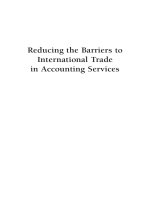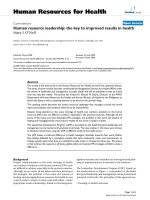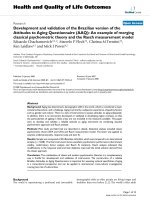The Microguide to Process Modeling in Bpmn 2.0 by MR Tom Debevoise and Rick Geneva_8 pdf
Bạn đang xem bản rút gọn của tài liệu. Xem và tải ngay bản đầy đủ của tài liệu tại đây (1.97 MB, 27 trang )
Calibration
Uncertainties
As in prediction, the data used to fit the process model can also be used to determine the
uncertainty of the calibration. Both the variation in the average response and in the new
observation of the response value need to be accounted for. This is similar to the uncertainty for
the prediction of a new measurement. In fact, approximate calibration confidence intervals are
actually computed by solving for the predictor variable value in the formulas for prediction
interval end points [Graybill (1976)]. Because , the standard deviation of the prediction of a
measured response, is a function of the predictor variable, like the regression function itself, the
inversion of the prediction interval endpoints is usually messy. However, like the inversion of the
regression function to obtain estimates of the predictor variable, it can be easily solved
numerically.
The equations to be solved to obtain approximate lower and upper calibration confidence limits,
are, respectively,
,
and
,
with
denoting the estimated standard deviation of the prediction of a new measurement.
and are both denoted as functions of the predictor variable, , here to make it clear
that those terms must be written as functions of the unknown value of the predictor variable. The
left-hand sides of the two equations above are used as arguments in the root-finding software, just
as the expression is used when computing the estimate of the predictor variable.
Confidence
Intervals for
the Example
Applications
Confidence intervals for the true predictor variable values associated with the observed values of
pressure (178) and voltage (1522) are given in the table below for the Pressure/Temperature
example and the Thermocouple Calibration example, respectively. The approximate confidence
limits and estimated values of the predictor variables were obtained numerically in both cases.
Example
Lower 95%
Confidence
Bound
Estimated
Predictor
Variable
Value
Upper 95%
Confidence
Bound
Pressure/Temperature 178 41.07564 43.31925 45.56146
Thermocouple Calibration 1522 553.0026 553.0187 553.0349
4.5.2.1. Single-Use Calibration Intervals
(3 of 5) [5/1/2006 10:22:32 AM]
Interpretation
of Calibration
Intervals
Although calibration confidence intervals have some unique features, viewed as confidence
intervals, their interpretation is essentially analogous to that of confidence intervals for the true
average response. Namely, in repeated calibration experiments, when one calibration is made for
each set of data used to fit a calibration function and each single new observation of the response,
then approximately
of the intervals computed as described above will capture
the true value of the predictor variable, which is a measurement on the primary measurement
scale.
The plot below shows 95% confidence intervals computed using 50 independently generated data
sets that follow the same model as the data in the Thermocouple calibration example. Random
errors from a normal distribution with a mean of zero and a known standard deviation are added
to each set of true temperatures and true voltages that follow a model that can be
well-approximated using LOESS to produce the simulated data. Then each data set and a newly
observed voltage measurement are used to compute a confidence interval for the true temperature
that produced the observed voltage. The dashed reference line marks the true temperature under
which the thermocouple measurements were made. It is easy to see that most of the intervals do
contain the true value. In 47 out of 50 data sets, or approximately 95%, the confidence intervals
covered the true temperature. When the number of data sets was increased to 5000, the
confidence intervals computed for 4657, or 93.14%, of the data sets covered the true temperature.
Finally, when the number of data sets was increased to 10000, 93.53% of the confidence intervals
computed covered the true temperature. While these intervals do not exactly attain their stated
coverage, as the confidence intervals for the average response do, the coverage is reasonably
close to the specified level and is probably adequate from a practical point of view.
Confidence
Intervals
Computed
from 50 Sets
of Simulated
Data
4.5.2.1. Single-Use Calibration Intervals
(4 of 5) [5/1/2006 10:22:32 AM]
4.5.2.1. Single-Use Calibration Intervals
(5 of 5) [5/1/2006 10:22:32 AM]
4. Process Modeling
4.5. Use and Interpretation of Process Models
4.5.3.How can I optimize my process using
the process model?
Detailed
Information
on Process
Optimization
Process optimization using models fit to data collected using response
surface designs is primarily covered in Section 5.5.3 of Chapter 5:
Process Improvement. In that section detailed information is given on
how to determine the correct process inputs to hit a target output value
or to maximize or minimize process output. Some background on the
use of process models for optimization can be found in Section 4.1.3.3
of this chapter, however, and information on the basic analysis of data
from optimization experiments is covered along with that of other types
of models in Section 4.1 through Section 4.4 of this chapter.
Contents of
Chapter 5
Section 5.5.3.
Optimizing a Process
Single response case
Path of steepest ascent1.
Confidence region for search path2.
Choosing the step length3.
Optimization when there is adequate quadratic fit4.
Effect of sampling error on optimal solution5.
Optimization subject to experimental region
constraints
6.
1.
Multiple response case
Path of steepest ascent1.
Desirability function approach2.
Mathematical programming approach3.
2.
1.
4.5.3. How can I optimize my process using the process model?
[5/1/2006 10:22:32 AM]
4. Process Modeling
4.6.Case Studies in Process Modeling
Detailed,
Realistic
Examples
The general points of the first five sections are illustrated in this section
using data from physical science and engineering applications. Each
example is presented step-by-step in the text and is often cross-linked
with the relevant sections of the chapter describing the analysis in
general. Each analysis can also be repeated using a worksheet linked to
the appropriate Dataplot macros. The worksheet is also linked to the
step-by-step analysis presented in the text for easy reference.
Contents:
Section 6
Load Cell Calibration
Background & Data1.
Selection of Initial Model2.
Model Fitting - Initial Model3.
Graphical Residual Analysis - Initial Model4.
Interpretation of Numerical Output - Initial Model5.
Model Refinement6.
Model Fitting - Model #27.
Graphical Residual Analysis - Model #28.
Interpretation of Numerical Output - Model #29.
Use of the Model for Calibration10.
Work this Example Yourself11.
1.
Alaska Pipeline Ultrasonic Calibration
Background and Data1.
Check for Batch Effect2.
Initial Linear Fit3.
Transformations to Improve Fit and Equalize Variances4.
Weighting to Improve Fit5.
Compare the Fits6.
Work This Example Yourself7.
2.
4.6. Case Studies in Process Modeling
(1 of 2) [5/1/2006 10:22:32 AM]
Ultrasonic Reference Block Study
Background and Data1.
Initial Non-Linear Fit2.
Transformations to Improve Fit3.
Weighting to Improve Fit4.
Compare the Fits5.
Work This Example Yourself6.
3.
Thermal Expansion of Copper Case Study
Background and Data1.
Exact Rational Models2.
Initial Plot of Data3.
Fit Quadratic/Quadratic Model4.
Fit Cubic/Cubic Model5.
Work This Example Yourself6.
4.
4.6. Case Studies in Process Modeling
(2 of 2) [5/1/2006 10:22:32 AM]
4. Process Modeling
4.6. Case Studies in Process Modeling
4.6.1.Load Cell Calibration
Quadratic
Calibration
This example illustrates the construction of a linear regression model for
load cell data that relates a known load applied to a load cell to the
deflection of the cell. The model is then used to calibrate future cell
readings associated with loads of unknown magnitude.
Background & Data1.
Selection of Initial Model2.
Model Fitting - Initial Model3.
Graphical Residual Analysis - Initial Model4.
Interpretation of Numerical Output - Initial Model5.
Model Refinement6.
Model Fitting - Model #27.
Graphical Residual Analysis - Model #28.
Interpretation of Numerical Output - Model #29.
Use of the Model for Calibration10.
Work This Example Yourself11.
4.6.1. Load Cell Calibration
[5/1/2006 10:22:33 AM]
4. Process Modeling
4.6. Case Studies in Process Modeling
4.6.1. Load Cell Calibration
4.6.1.1.Background & Data
Description
of Data
Collection
The data collected in the calibration experiment consisted of a known
load, applied to the load cell, and the corresponding deflection of the
cell from its nominal position. Forty measurements were made over a
range of loads from 150,000 to 3,000,000 units. The data were collected
in two sets in order of increasing load. The systematic run order makes
it difficult to determine whether or not there was any drift in the load
cell or measuring equipment over time. Assuming there is no drift,
however, the experiment should provide a good description of the
relationship between the load applied to the cell and its response.
Resulting
Data
Deflection Load
0.11019 150000
0.21956 300000
0.32949 450000
0.43899 600000
0.54803 750000
0.65694 900000
0.76562 1050000
0.87487 1200000
0.98292 1350000
1.09146 1500000
1.20001 1650000
1.30822 1800000
1.41599 1950000
1.52399 2100000
1.63194 2250000
1.73947 2400000
1.84646 2550000
1.95392 2700000
2.06128 2850000
2.16844 3000000
0.11052 150000
4.6.1.1. Background & Data
(1 of 2) [5/1/2006 10:22:33 AM]
0.22018 300000
0.32939 450000
0.43886 600000
0.54798 750000
0.65739 900000
0.76596 1050000
0.87474 1200000
0.98300 1350000
1.09150 1500000
1.20004 1650000
1.30818 1800000
1.41613 1950000
1.52408 2100000
1.63159 2250000
1.73965 2400000
1.84696 2550000
1.95445 2700000
2.06177 2850000
2.16829 3000000
4.6.1.1. Background & Data
(2 of 2) [5/1/2006 10:22:33 AM]
4. Process Modeling
4.6. Case Studies in Process Modeling
4.6.1. Load Cell Calibration
4.6.1.2.Selection of Initial Model
Start
Simple
The first step in analyzing the data is to select a candidate model. In the case of a measurement
system like this one, a fairly simple function should describe the relationship between the load
and the response of the load cell. One of the hallmarks of an effective measurement system is a
straightforward link between the instrumental response and the property being quantified.
Plot the
Data
Plotting the data indicates that the hypothesized, simple relationship between load and deflection
is reasonable. The plot below shows the data. It indicates that a straight-line model is likely to fit
the data. It does not indicate any other problems, such as presence of outliers or nonconstant
standard deviation of the response.
Initial
Model:
Straight
Line
4.6.1.2. Selection of Initial Model
(1 of 2) [5/1/2006 10:22:33 AM]
4.6.1.2. Selection of Initial Model
(2 of 2) [5/1/2006 10:22:33 AM]
4. Process Modeling
4.6. Case Studies in Process Modeling
4.6.1. Load Cell Calibration
4.6.1.3.Model Fitting - Initial Model
Least
Squares
Estimation
Using software for computing least squares parameter estimates, the straight-line
model,
is easily fit to the data. The computer output from this process is shown below.
Before trying to interpret all of the numerical output, however, it is critical to check
that the assumptions underlying the parameter estimation are met reasonably well.
The next two sections show how the underlying assumptions about the data and
model are checked using graphical and numerical methods.
Dataplot
Output
LEAST SQUARES POLYNOMIAL FIT
SAMPLE SIZE N = 40
DEGREE = 1
REPLICATION CASE
REPLICATION STANDARD DEVIATION = 0.2147264895D-03
REPLICATION DEGREES OF FREEDOM = 20
NUMBER OF DISTINCT SUBSETS = 20
PARAMETER ESTIMATES (APPROX. ST. DEV.) T VALUE
1 A0 0.614969E-02 (0.7132E-03) 8.6
2 A1 0.722103E-06 (0.3969E-09) 0.18E+04
RESIDUAL STANDARD DEVIATION = 0.0021712694
RESIDUAL DEGREES OF FREEDOM = 38
REPLICATION STANDARD DEVIATION = 0.0002147265
REPLICATION DEGREES OF FREEDOM = 20
LACK OF FIT F RATIO = 214.7464 = THE 100.0000% POINT OF
THE F DISTRIBUTION WITH 18 AND 20 DEGREES OF FREEDOM
4.6.1.3. Model Fitting - Initial Model
(1 of 2) [5/1/2006 10:22:34 AM]
4.6.1.3. Model Fitting - Initial Model
(2 of 2) [5/1/2006 10:22:34 AM]
4. Process Modeling
4.6. Case Studies in Process Modeling
4.6.1. Load Cell Calibration
4.6.1.4.Graphical Residual Analysis - Initial Model
Potentially
Misleading
Plot
After fitting a straight line to the data, many people like to check the quality of the fit with a plot
of the data overlaid with the estimated regression function. The plot below shows this for the load
cell data. Based on this plot, there is no clear evidence of any deficiencies in the model.
Avoiding the
Trap
This type of overlaid plot is useful for showing the relationship between the data and the
predicted values from the regression function; however, it can obscure important detail about the
model. Plots of the residuals, on the other hand, show this detail well, and should be used to
check the quality of the fit. Graphical analysis of the residuals is the single most important
technique for determining the need for model refinement or for verifying that the underlying
assumptions of the analysis are met.
4.6.1.4. Graphical Residual Analysis - Initial Model
(1 of 4) [5/1/2006 10:22:34 AM]
Residual plots of interest for this model include:
residuals versus the predictor variable1.
residuals versus the regression function values2.
residual run order plot3.
residual lag plot4.
histogram of the residuals5.
normal probability plot6.
A plot of the residuals versus load is shown below.
Hidden
Structure
Revealed
Scale of Plot
Key
The structure in the relationship between the residuals and the load clearly indicates that the
functional part of the model is misspecified. The ability of the residual plot to clearly show this
problem, while the plot of the data did not show it, is due to the difference in scale between the
plots. The curvature in the response is much smaller than the linear trend. Therefore the curvature
is hidden when the plot is viewed in the scale of the data. When the linear trend is subtracted,
however, as it is in the residual plot, the curvature stands out.
The plot of the residuals versus the predicted deflection values shows essentially the same
structure as the last plot of the residuals versus load. For more complicated models, however, this
plot can reveal problems that are not clear from plots of the residuals versus the predictor
variables.
4.6.1.4. Graphical Residual Analysis - Initial Model
(2 of 4) [5/1/2006 10:22:34 AM]
Similar
Residual
Structure
Additional
Diagnostic
Plots
Further residual diagnostic plots are shown below. The plots include a run order plot, a lag plot, a
histogram, and a normal probability plot. Shown in a two-by-two array like this, these plots
comprise a 4-plot of the data that is very useful for checking the assumptions underlying the
model.
Dataplot
4plot
4.6.1.4. Graphical Residual Analysis - Initial Model
(3 of 4) [5/1/2006 10:22:34 AM]
Interpretation
of Plots
The structure evident in these residual plots also indicates potential problems with different
aspects of the model. Under ideal circumstances, the plots in the top row would not show any
systematic structure in the residuals. The histogram would have a symmetric, bell shape, and the
normal probability plot would be a straight line. Taken at face value, the structure seen here
indicates a time trend in the data, autocorrelation of the measurements, and a non-normal
distribution of the residuals.
It is likely, however, that these plots will look fine once the function describing the systematic
relationship between load and deflection has been corrected. Problems with one aspect of a
regression model often show up in more than one type of residual plot. Thus there is currently no
clear evidence from the 4-plot that the distribution of the residuals from an appropriate model
would be non-normal, or that there would be autocorrelation in the process, etc. If the 4-plot still
indicates these problems after the functional part of the model has been fixed, however, the
possibility that the problems are real would need to be addressed.
4.6.1.4. Graphical Residual Analysis - Initial Model
(4 of 4) [5/1/2006 10:22:34 AM]
4. Process Modeling
4.6. Case Studies in Process Modeling
4.6.1. Load Cell Calibration
4.6.1.5.Interpretation of Numerical Output - Initial
Model
Lack-of-Fit
Statistic
Interpretable
The fact that the residual plots clearly indicate a problem with the specification of
the function describing the systematic variation in the data means that there is little
point in looking at most of the numerical results from the fit. However, since there
are replicate measurements in the data, the lack-of-fit test can also be used as part of
the model validation. The numerical results of the fit from Dataplot are list below.
Dataplot
Output
LEAST SQUARES POLYNOMIAL FIT
SAMPLE SIZE N = 40
DEGREE = 1
REPLICATION CASE
REPLICATION STANDARD DEVIATION = 0.2147264895D-03
REPLICATION DEGREES OF FREEDOM = 20
NUMBER OF DISTINCT SUBSETS = 20
PARAMETER ESTIMATES (APPROX. ST. DEV.) T VALUE
1 A0 0.614969E-02 (0.7132E-03) 8.6
2 A1 0.722103E-06 (0.3969E-09) 0.18E+04
RESIDUAL STANDARD DEVIATION = 0.0021712694
RESIDUAL DEGREES OF FREEDOM = 38
REPLICATION STANDARD DEVIATION = 0.0002147265
REPLICATION DEGREES OF FREEDOM = 20
LACK OF FIT F RATIO = 214.7464 = THE 100.0000% POINT OF
THE F DISTRIBUTION WITH 18 AND 20 DEGREES OF FREEDOM
Function
Incorrect
The lack-of-fit test statistic is 214.7534, which also clearly indicates that the
functional part of the model is not right. The 95% cut-off point for the test is 2.15.
Any value greater than that indicates that the hypothesis of a straight-line model for
this data should be rejected.
4.6.1.5. Interpretation of Numerical Output - Initial Model
(1 of 2) [5/1/2006 10:22:35 AM]
4.6.1.5. Interpretation of Numerical Output - Initial Model
(2 of 2) [5/1/2006 10:22:35 AM]
4. Process Modeling
4.6. Case Studies in Process Modeling
4.6.1. Load Cell Calibration
4.6.1.6.Model Refinement
After ruling out the straight line model for these data, the next task is to decide what function
would better describe the systematic variation in the data.
Reviewing the plots of the residuals versus all potential predictor variables can offer insight into
selection of a new model, just as a plot of the data can aid in selection of an initial model.
Iterating through a series of models selected in this way will often lead to a function that
describes the data well.
Residual
Structure
Indicates
Quadratic
The horseshoe-shaped structure in the plot of the residuals versus load suggests that a quadratic
polynomial might fit the data well. Since that is also the simplest polynomial model, after a
straight line, it is the next function to consider.
4.6.1.6. Model Refinement
(1 of 2) [5/1/2006 10:22:35 AM]
4.6.1.6. Model Refinement
(2 of 2) [5/1/2006 10:22:35 AM]
4. Process Modeling
4.6. Case Studies in Process Modeling
4.6.1. Load Cell Calibration
4.6.1.7.Model Fitting - Model #2
New
Function
Based on the residual plots, the function used to describe the data should be the
quadratic polynomial:
The computer output from this process is shown below. As for the straight-line
model, however, it is important to check that the assumptions underlying the
parameter estimation are met before trying to interpret the numerical output. The
steps used to complete the graphical residual analysis are essentially identical to
those used for the previous model.
Dataplot
Output
for
Quadratic
Fit
LEAST SQUARES POLYNOMIAL FIT
SAMPLE SIZE N = 40
DEGREE = 2
REPLICATION CASE
REPLICATION STANDARD DEVIATION = 0.2147264895D-03
REPLICATION DEGREES OF FREEDOM = 20
NUMBER OF DISTINCT SUBSETS = 20
PARAMETER ESTIMATES (APPROX. ST. DEV.) T VALUE
1 A0 0.673618E-03 (0.1079E-03) 6.2
2 A1 0.732059E-06 (0.1578E-09) 0.46E+04
3 A2 -0.316081E-14 (0.4867E-16) -65.
RESIDUAL STANDARD DEVIATION = 0.0002051768
RESIDUAL DEGREES OF FREEDOM = 37
REPLICATION STANDARD DEVIATION = 0.0002147265
REPLICATION DEGREES OF FREEDOM = 20
LACK OF FIT F RATIO = 0.8107 = THE 33.3818% POINT OF
THE F DISTRIBUTION WITH 17 AND 20 DEGREES OF FREEDOM
4.6.1.7. Model Fitting - Model #2
(1 of 2) [5/1/2006 10:22:35 AM]
4.6.1.7. Model Fitting - Model #2
(2 of 2) [5/1/2006 10:22:35 AM]
4. Process Modeling
4.6. Case Studies in Process Modeling
4.6.1. Load Cell Calibration
4.6.1.8.Graphical Residual Analysis - Model #2
The data with a quadratic estimated regression function and the residual plots are shown below.
Compare
to Initial
Model
This plot is almost identical to the analogous plot for the straight-line model, again illustrating the
lack of detail in the plot due to the scale. In this case, however, the residual plots will show that
the model does fit well.
4.6.1.8. Graphical Residual Analysis - Model #2
(1 of 4) [5/1/2006 10:22:36 AM]
Plot
Indicates
Model
Fits Well
The residuals randomly scattered around zero, indicate that the quadratic is a good function to
describe these data. There is also no indication of non-constant variability over the range of loads.
Plot Also
Indicates
Model
OK
4.6.1.8. Graphical Residual Analysis - Model #2
(2 of 4) [5/1/2006 10:22:36 AM]









